Content
- 1 Dates of planting tulips in the ground
- 2 Planting tulips for outdoor cultivation
- 3 Caring for tulips after planting in open ground
- 4 Features of growing tulips in the open field
- 5 Choosing bulbs for planting
- 6 Time and timing of planting tulips
- 7 How to plant tulips correctly?
- 8 Tulip care
- 9 Features of care after flowering
- 10 Protection against diseases and pests
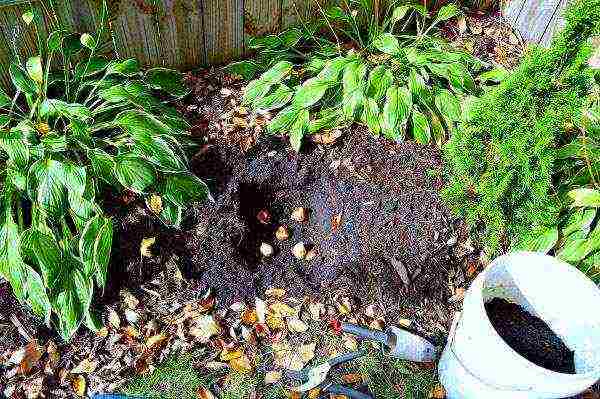 The blooming of tulips heralds the triumph of spring. If the site is decorated with tulips year after year, planting and caring in the open field is the key to this success. Perennial bulbous plants native to Asia have long been the subject of admiration both in their homeland and in the Old World, where they got in the middle of the 16th century.
The blooming of tulips heralds the triumph of spring. If the site is decorated with tulips year after year, planting and caring in the open field is the key to this success. Perennial bulbous plants native to Asia have long been the subject of admiration both in their homeland and in the Old World, where they got in the middle of the 16th century.
Thanks to the universal love for these flowers, a hundred years later, Holland began to be called the land of tulips, and today tens of thousands of varieties of these spectacular, but quite affordable plants are distributed around the world.
Dates of planting tulips in the ground
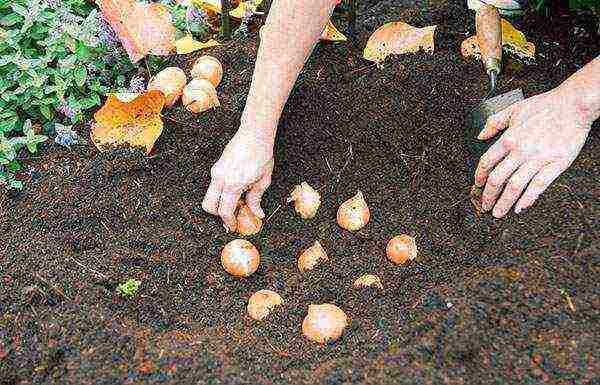 Tulips of cultivars bloom in spring or in the first half of summer. Therefore, the optimal planting time is autumn. In 3-4 weeks, the bulbs acclimate and form the root system, but do not form the aerial part. This allows the tulips to winter well, and with the arrival of warmth, give strong foliage and open large corollas.
Tulips of cultivars bloom in spring or in the first half of summer. Therefore, the optimal planting time is autumn. In 3-4 weeks, the bulbs acclimate and form the root system, but do not form the aerial part. This allows the tulips to winter well, and with the arrival of warmth, give strong foliage and open large corollas.
When determining the date of planting tulips, it is important not to be mistaken! If the bulbs enter the soil too early, they can produce foliage. And the coming winter will take the plants by surprise. The aboveground part will freeze, the underground part will weaken and will not be able to guarantee spring bloom. Late planting threatens that tulips will not have time to take root, severe frosts will kill them or spoil them.
How to choose the optimal time? When to plant tulips in the ground in different regions?
Experienced flower growers advise you to pay attention not to the calendar, but to the weather outside the window. The best start for plants is to plant in soil that has cooled to 10–12 ° C.
In the middle lane, such conditions develop by mid-September. To the south, tulips are planted later, to the north, the dates are shifted to the end of August.
If, for some reason, tulips did not hit the flower beds in the fall, you can plant them in the spring. Unfortunately, in this case, the plants have less time to prepare for flowering and accumulate nutrients for the next year. To get the desired result and to simplify the care of tulips outdoors, it is better to germinate the bulbs in peat pots filled with a loose nutrient substrate before planting. Before planting, the bulbs are cooled for 24 hours in the vegetable compartment of the refrigerator.
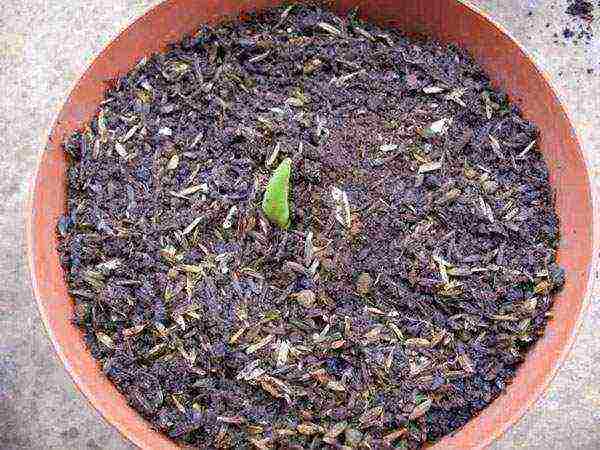 Tulips are transferred to flower beds when it gets warmer and the soil warms up to +15 ° C. This method can be used in all regions, including areas where open field tulips do not survive the winter.
Tulips are transferred to flower beds when it gets warmer and the soil warms up to +15 ° C. This method can be used in all regions, including areas where open field tulips do not survive the winter.
Planting tulips for outdoor cultivation
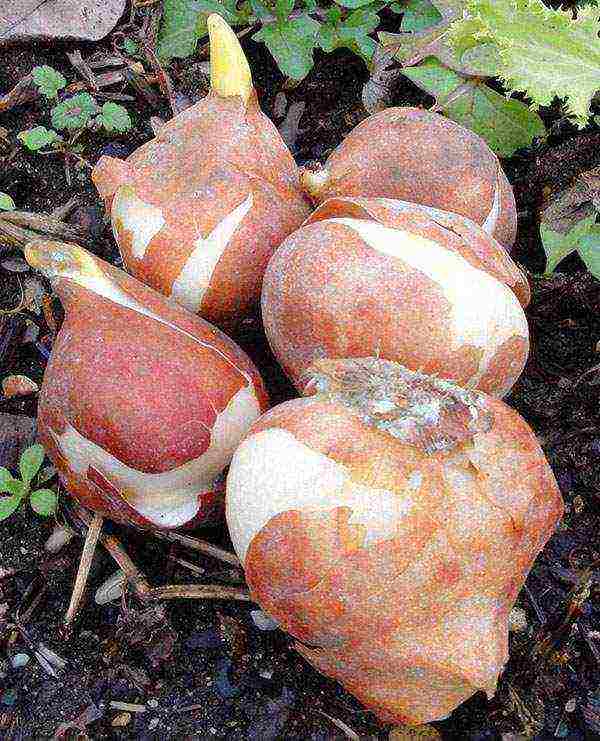 For bright flowering garden tulips require:
For bright flowering garden tulips require:
- sun or transparent partial shade;
- nutritious, necessarily loose soil with a neutral or slightly alkaline reaction;
- wind protection;
- moderate watering.
A site suitable for growing tulips is dug up on a full bayonet, loosened, breaking clods, weeds are selected and nitrogen and potash fertilizers are applied, for example, humus and wood ash. Dense, heavy soil is mixed with sand, peat.
Under tulips, as well as under other bulbous crops, you should not add fresh organic matter, which is often a source of bacterial rot and fungal diseases.
The depth of the open field furrows depends on the size of the bulbs.Therefore, they are pre-sorted, along the way separating sick and damaged specimens. And healthy ones are immersed in a dense pink solution of potassium permanganate for half an hour and thoroughly dried.
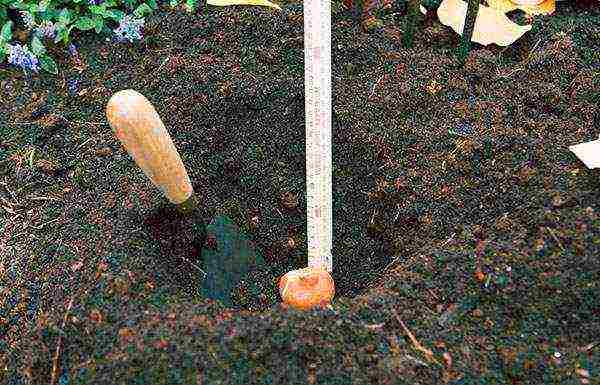 Under adult large bulbs, furrows are made with a depth of 20 to 30 cm, pouring a 10-cm drainage cushion of coarse sand on the bottom. The children are planted, slightly pressing, into the holes with the same drainage, but half as small, that is, to a depth of 7-10 cm. When the soil is leveled, the plot is mulched.
Under adult large bulbs, furrows are made with a depth of 20 to 30 cm, pouring a 10-cm drainage cushion of coarse sand on the bottom. The children are planted, slightly pressing, into the holes with the same drainage, but half as small, that is, to a depth of 7-10 cm. When the soil is leveled, the plot is mulched.
Caring for tulips after planting in open ground
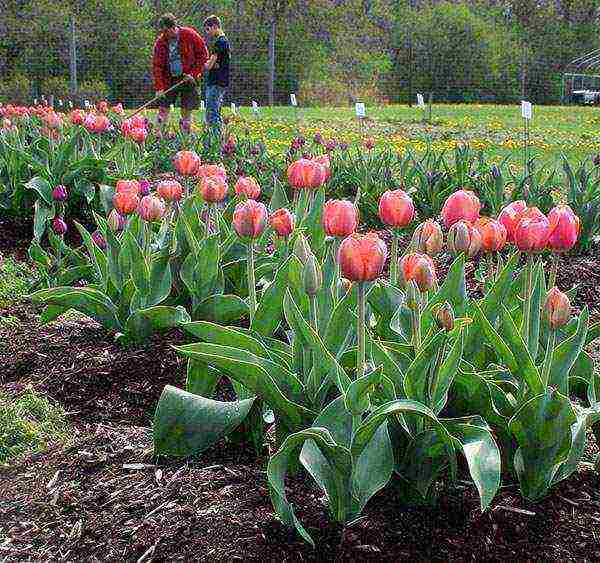 Tulips will respond only to constant and competent care with massive disclosure of bright flowers. Bulbous crops, as a rule, are unpretentious, but still require attention from the appearance of the first leaves until late autumn. Caring for tulips after planting includes:
Tulips will respond only to constant and competent care with massive disclosure of bright flowers. Bulbous crops, as a rule, are unpretentious, but still require attention from the appearance of the first leaves until late autumn. Caring for tulips after planting includes:
- watering, especially plentiful during a set of buds, mass flowering and within 2 weeks after its completion;
- removal of weeds around plantings;
- careful not to damage the root system and bulbs, loosening;
- triple feeding of flowers.
After watering, the soil under the plants should be moist at a depth of 30–40 cm, that is, at least 10–40 liters of water should be consumed per square meter, depending on the type of soil.
Fertilizers in liquid or granular form are part of post-planting tulip care. They are brought in three times:
- In the phase of the appearance of the first shoots, using a mixture of 2 parts of nitrogen, 2 parts of phosphorus salts, 1 part of potassium compounds;
- By the time the green buds appear, feeding the plants with nitrogen, phosphorus and potassium in a ratio of 1: 2: 2;
- After flowering, using potassium-phosphorus formulations, completely abandoning nitrogen.
Speaking of tulip care, we must not forget about a simple but useful procedure. When the flowers wither, they are cut out along with the peduncles. This will prevent the bulbs from wasting the energy that is precious for the growth of the bulbs.
If boxes with seeds are formed and ripen on the stems, there is no need to wait for large bulbs, and the children will not be able to gain significant mass.
Before growing tulips, you need to know that a culture can be in one place for no more than 4 years. Then the risk of accumulation of dangerous bacteria, fungi and soil pests increases, the bulbs naturally age and require replanting. The bulbs remaining in the soil gradually go deeper, so the next year it is more difficult for the sprouts to break through to the surface. As a result, the flowers become smaller, the peduncles become weaker and shorter.
The tulips are dug up when the leaves completely wither and fall off. It is useful to shed the freed area with a solution of phytosporin, potassium permanganate or any available fungicide. Plants that remain in the soil for the winter are thickly mulched with peat, sawdust or covered with spruce branches to avoid freezing.
Video about the correct planting of tulips
Tulip fever, which began in Holland half a millennium ago and took over the whole world, continues today. There is not a single grower or gardener who would not dream of expanding his collection of tulip varieties and who would not be familiar with this special bulbous star. Tulips do not need an introduction, but the nuances of this in their cultivation does not diminish, as well as the options for their use in the design of the garden.
Content
- Description of tulips
- The use of tulips in garden decoration
- Selection of partners for tulips
- Conditions necessary for tulips
- Planting tulips
- Tulip humidity and watering requirements
- Top dressing for tulips
- Crops on tulips
- Additional care for tulips
- Monitoring the development of tulips
- Digging tulips and preserving outside the soil
- Wintering tulips
- Pests and diseases of tulips
- Propagation of tulips
A simple portrait of a tricky tulip
Representing the Liliaceae family, tulips are, without exaggeration, the most popular and widespread bulbs.To a lesser extent, they can be called the most diverse, because the number of varieties and varieties of tulips is measured not in hundreds, but in tens of thousands, and the choice in shape, structure, and color of flowers increases from year to year. And although it is not easy to understand the classification of tulips, it is impossible to confuse tulips with other bulbs.
Representatives of the Tulip genus are bulbous perennials with a modified stem. All plant organs are laid in a pear-shaped or ovoid bulb. The generations of the bulbs change annually: during the growing season, young bulbs are laid, and the faded ones die off. The buds of peduncles and flowers develop in the bulbs during the summer dormant period. In autumn, the bulbs take root, the process of flower stalk is completed, and after wintering, active growth and flowering take place, and the cycle repeats again.
The development of tulips is so rapid that one cannot help but be surprised at the shortened, but amazingly active vegetation of this bulbous. Tulips quickly develop not only leaves and peduncles, but also a bulb, roots, daughter bulbs. On average, in regions with harsh winters, the entire growing season of tulips spans only 3 months from leaf formation to flowering and replacement bulbs. During a period of such active development, both conditions and care are very important for tulips, which must compensate for any vagaries of the weather.
Tulip bulbs consist of a bottom and one to six storage scales covered with protective integumentary scales. The bulbs produce underground stolons, leaves and strong, succulent flower stalks. Each bulb hides buds embedded in it, from which new bulbs are formed - the central (replacement bulb), daughter bulbs (from the buds hidden in the sinuses of storing scales) and children developing in the axils of the covering scales.
The height of tulip peduncles ranges from less than 30 cm to more than half a meter. Leaves are fleshy, grasping the stem, elongated-oval, whole-edged, rather tough, shrinking from the lower leaf to the uppermost. Up to 5 leaves sit on one stem, although tulips are often limited to only two leaves.
Tulips most often produce single flowers, in the structure of which five concentric circles can be distinguished, obeying three-ray or triangular symmetry. They are easily recognized by the six-member perianth: the flower always consists of six petals or equal to them six in number of lobes in simple tulips. Distinctive features of tulips are six, also arranged in two circles, stamens, and a three-lobed stigma of the pistil. The flowers themselves in this bulbous are strikingly diverse - from simple to double, goblet, lily-colored, cupped, oval and even star-shaped - to parrot and fantasy forms.
Colors differ by no less variety. Tulips are solid and multi-colored, pastel and bright, exotic and classic. White, pink, red, purple, yellow, orange are not the only options. The color range of tulips includes blue and blue, and shades of green, and natural paints closest to black.
The flowering period of tulips starts with the first early varieties in April and ends only in June. Despite the extremely limited flowering period of each individual plant, the selection of tulip varieties allows you to stretch the parade of this bulbous star for almost 3 months. After flowering, dense fruit pods ripen.
The variety of tulips is simply unimaginable. More than 100 natural species, crossing of which gave rise to more than 17 thousand registered varieties, which in turn are divided into classes, groups, subclasses, categories ... Most tulips are derived from botanical plant species from the Middle East, Central Asia and Europe.Traditionally, the market is dominated by Dutch tulips, but dozens of new varieties appear almost every year in many garden centers around the world.
The only correct criterion for choosing tulips is buying plants according to your tastes and preferences, the choice is primarily based on aesthetic characteristics. After all, tulips really allow everyone to choose plants to their liking, making the collection as individual and bright as possible.
Growing tulips
Tulips are spring-blooming stars that have long become indispensable for decorating any garden. They are collected, used as small seasonal accents, or turned into the main star of the spring garden. And they grow only in groups, since it is easy for single plants to get lost.
Tulips are placed in islands, spots, strict-shaped "pockets". If the plants are planted separately, they are placed so that later it is easy to fill the area with annual stars, most often with strict contours of the tulip area. On flower beds and in complex compositions, planting with strict forms or lines is inferior in popularity to the placement of these bulbous irregular groups - from small "spots" of 5-7 bulbs to larger islets.
Tulips in the garden can be used:
- on flower beds and ceremonial flower beds;
- in discounts;
- in spring spots and islets on the lawn, under shrubs and trees;
- in borders and ribbon flower beds;
- in flower beds of annuals;
- in rock gardens and rockeries;
- in potted gardens, containers, flower girls both in the garden and on balconies, terraces, in room culture.
Tulips are a valuable cut crop. They are driven out especially for the holidays and early spring, used for complex arrangements and simple bouquets.
Selection of partners for tulips
The status of one of the most common plants leaves its mark on the choice of partners: these bulbs are luxurious blooming spring accents, medium-sized, but stunningly beautiful stars that should always remain in the foreground. For tulips, there is no need to select partners to reveal their beauty, they go well with garden plants that can grow in conditions similar to them - from shrubs and woody to herbaceous perennials, other bulbous and tuberous plants, annuals and seasonal stars. If tulips are introduced to flower beds, then they are combined with plants that can fill the voids and then hide their wilting greens.
The best partners for tulips from among herbaceous perennials are hosts, phloxes, astilbe, garden geraniums, daylilies, cuffs, tenacious, arabis, obrieta. Among spring flowering plants, tulips are most often combined with daffodils, forget-me-nots, violets, muscari and primroses, but tulips with hyacinths, anemones, hellebore no worse set off the beauty of each other.
Species and varietal tulips - plants are different both in the degree of decorativeness, size, variability, color of flowers, and in their endurance and unpretentiousness. Species tulips, with rare exceptions, are plants that can be “planted and forgotten”. Their agricultural technology is much simpler and deserves separate consideration. Varietal tulips are less persistent, reveal the beauty of flowering most fully when harvested annually, and are vulnerable to diseases and pests. Growing varietal tulips is not such a difficult task. But in caring for a plant there are many important nuances that should never be forgotten.
Conditions necessary for tulips
Bulbous favorites can be called undemanding plants only conditionally: tulips bloom and grow only in favorable conditions, both lighting and soil characteristics are important for them.
Tulips are light-loving crops that are planted in sunny places or in diffused bright lighting.The later the tulip variety blooms, the better it tolerates light shading, but for varietal tulips, a sunny location is still more preferable. Tulips are not afraid of the neighborhood of large shrubs or trees, if the leaves of the latter bloom late and bulbs do not suffer from strong shading during flowering.
For tulips, only high-quality, deeply worked garden soils are suitable. This bulbous plant is grown in sandy loam and loam, loose, drained, light and nutritious soils. The reaction of the soil for tulips is very important: this bulbous does not tolerate an acidic environment, it is planted only in neutral or slightly alkaline soils. Before planting, the soil is adjusted to optimal texture and composition. Tulips cannot stand fresh organic matter.
Areas for growing tulips should be flat or slightly sloped, warm, well heated. Plants are better protected not only from the risk of stagnant water, but also from drafts or winds.
When choosing a place for growing tulips, it should be borne in mind that when grown for five years in a row in the same place, the risks of plant infection with pests and diseases increase. Tulips are not planted after daffodils, lilies and other bulbs, often affected by the same viruses and diseases.
Late tulip (Tulipa tarda) Planting tulips
It is better to prepare for planting tulips in advance. Any organic fertilizers, except for compost and humus, should be applied to the soil only a few years before planting, preferably under the previous crop. Preplant soil improvement comes down to several procedures:
- deep digging (at least 30 cm, with a selection of weed roots);
- correction of the composition of sandy and clay soils;
- the introduction of humus or compost (2 buckets per square meter), wood ash (1 glass per square meter) and mineral fertilizers.
When improving the soil, a standard (40-60 g) portion of phosphorus-potassium fertilizers is introduced into it. Superphosphate can be poured into the bottom of the planting pits or mixed with soil. It is better to apply nitrogen fertilizers just before planting. If mineral fertilizers were not added to the soil in advance, then before planting, full mineral fertilizers are used in a proportion of 100 g per square meter of soil.
The preparation of the landing site is carried out at least a month before the tulips are planted. If the risk of water stagnation is increased on the site or the groundwater is high, then a high drainage layer must be laid under the entire bed.
Tulips are planted from the third decade of August to the first decade of October. September is traditionally called the "tulip" month, but if the weather is favorable, the time for planting tulips can be extended. For the middle lane, you can focus on the temperature: tulips are planted when the soil temperature drops to 10 degrees Celsius at a depth of 10 cm.Late planting dates are determined so that the bulb has 20-30 days before stable frost for their high-quality rooting.
All bulbs must be re-inspected carefully before planting in the soil. Any deviations in appearance, signs of lesions or decay are the basis for culling. Particular attention should be paid to traces of viral lesions and bulb mites.
It is advisable to plant bulbs sorted by size separately, without mixing them with each other. Large and small bulbs are planted together only if they are not planned to be dug up annually.
The bulbs are also treated with fungicide solutions before planting (the classic version is a solution of potassium permanganate with a concentration of 0.5%). Etching is carried out for half an hour or an hour. The bulbs are planted without drying.
Tulips are planted depending on how large the group will be and what is the role of tulips in flower beds.If tulips are planted in a small spot or island, then planting can be carried out in a large common shallow planting hole. When planting over a large area, planting is carried out in trenches. The depth of the pits or trenches for planting tulips is about 20 cm.
The distance between the bulbs when planting tulips depends on both their size and whether they plan to dig up the plants annually. If tulips are constantly planted and dug up, then the plants can be placed compacted to achieve a decorative effect or at an optimal density of 10-15 cm.When planting with a more rare digging, the minimum distance between large bulbs is about 20 cm. 15 cm. The optimal planting density is 50 large and up to 100 small tulip bulbs for each square meter of planting.
If the tulip bulbs are the same size, then planting is carried out in one step. If large and small bulbs are planted on the same site, then at the beginning, larger bulbs are installed (for planting), slightly cover them with earth, and then smaller bulbs are laid out between them. There can be 2 or 3 such "floors" when planting tulips.
Tulip bulbs are always installed strictly horizontally, bottom down. Planting depths range from 10 to 15 cm, but it is always best to use a universal rule and leave the distance between the bottom of the bulb and the soil surface at 3 bulb heights on light and loose soils and 2 bulb heights for heavy and dense soils. Such a guide will allow you to find the optimal depth individually for each tulip. The maximum depth for tulips is limited to 20 cm. Small bulbs can be sown, large and medium bulbs are always set individually. When planting tulips, you need to act carefully and minimize pressure on your bulb: indentation, application of force, especially after pickling in fungicide solutions, leads to injury to the root buds and even the bottom of the bulb. Tulips are neatly laid, effortlessly fill the planting pits with soil and compact it by watering, not tamping.
After planting for winter, tulips are prepared in the same way as plants that were not dug out of the soil, according to general rules.
Planting tulips in containers and various containers is carried out at the same time as in the soil. Plants are planted in autumn in a high-quality, loose, nutritious substrate at an optimal depth, most often in tiers with smaller bulbous crops. Drainage is required. Bulbs in containers are stored in a cold and dark room or with careful shelter in the garden. Expose to light and heat containers only after the appearance of the first shoots.
Planting tulip bulbs
Like all bulbous tulips, tulips cannot stand dampness and waterlogging. But it is difficult to call them drought-resistant crops. During the active period of development and ripening of the bulb, tulips need stable light soil moisture, because their extremely rapid development, the structural features of the root system require a large supply of moisture and really regular watering.
In the spring, before the beginning of budding, watering for the plant is carried out only in dry weather. Systemic irrigation for tulips begins only from the budding stage. The classic frequency for a tulip is 1 plentiful watering per week (from 10 to 40 liters of water per square meter of planting), but you always need to focus on the condition of the soil at the depth of the roots. Watering is completed not immediately after flowering, but after two weeks, so that the plants do not experience problems with access to moisture during the formation of the replacement bulb.
When watering tulips, you should take care not to soak the leaves of the plant, to water in the aisles. Tulips are watered in the early morning or evening according to standard rules, not cold water.
Top dressing for tulips
It is impossible to grow varietal tulips without feeding.To admire the luxurious flowers that fully reveal the beauty of each variety, it is necessary to create conditions in which the plants will not lack nutrients. But at the same time, tulips do not like an excess of fertilizers, accumulation of salts in the soil. Systemic, but moderate procedures help to find the “golden mean” in feeding for these bulbous plants.
Tulips prefer easily digestible fertilizers dissolved in water. It is possible to scatter mineral fertilizers over the soil, but only when combined with abundant watering and eliminating the risk of any fertilizer particles getting on the leaves, which must be dry, so you need to work very carefully).
Top dressing for tulips is applied several times per season:
In early spring
The first dressing for tulips is carried out as early as possible, applying fertilizer in the snow or immediately after it has melted. For early spring feeding, use a halved portion of complete mineral fertilizers (15-30 g per square meter of planting). Instead of universal fertilizers, you can use special mixtures for bulbous or tulips, a mixture of nitrogen, phosphorus and potassium fertilizers in a ratio of 2: 2: 1 in an amount of 40-45 g.
At the stage of budding
The second dressing for tulips is applied at the stage of flower stem and bud formation, supporting their normal development. For this top dressing, you can use only phosphorus-potassium fertilizers (25-35 g) or a mixture of nitrogen, phosphorus and potassium fertilizers with a different ratio - 1: 2: 2.
After flowering
This dressing is carried out to support the development of the daughter bulb and the optimal ripening of the bulbs for the winter. It is advisable to carry out top dressing exactly one week after the plants have flowered, but it can also be applied at the peak or at the end of flowering. For the third top dressing, only phosphorus-potassium fertilizers are used in the amount of 30-35 g for each square meter of soil.
For small tulips and baby bulbs in growing, it is better to limit yourself to just two dressings - in the spring and at the budding stage.
Tulips prefer ammonium nitrate, double superphosphate and potassium nitrate, complex preparations for bulbous, containing not only macro-, but also microelements (boron, zinc are especially important for tulips).
Tulips, like many other bulbs, themselves signal improper feeding and nutrient needs. All three macronutrients are equally important for these bulbs. Therefore, it is impossible to reduce or eliminate nitrogen to obtain better flowering in these bulbous plants. With a lack of nitrogen in tulips, they become smaller, become narrower and droop, leaf plates lose their elasticity, flower stalks turn red, and the process of bulb replacement is disrupted. With a lack of potassium or phosphorus, tulips also signal this with their leaves, along the edges of which a bluish color appears, flowering and root system suffer. If you take measures in time and carry out additional feeding, you can prevent these problems in the development of plants and prevent the lack of certain nutrients from affecting also flowering and reproduction.
Sprouted tulip bulbs
Tulips develop rapidly, but with the end of flowering they also quickly lose their decorative effect. Fading yellow foliage will not decorate any composition, even in a natural style. But, like all bulbs, the leaves of tulips should not be cut off; they cannot be removed until they die off on their own, otherwise the process of storing nutrients and ripening of bulbs will be disrupted.
In the cultivation of varietal tulips, limitation of fruiting plays a very important role. The formation of a seed pod in tulips most often leads to the fact that a full-fledged replacement bulb is not formed, the plant "breaks up" into a nest of very small bulbs that can fully bloom only after a few years.To prevent tulips from becoming smaller, the varieties should not allow fruiting, timely removing wilted flowers after the petals begin to wither.
Pruning flowers in a tulip is not as easy as it seems:
Cut for bouquets
It is carried out in the early morning, in a state of tightly closed buds, cutting off the stem at an angle. For bouquets, it is preferable to cut off the buds that have just begun to stain. The tulips are kept cool and in partial shade, the cuts are refreshed under water before placing the plants in the water.
Cutting withered flowers
It is better to carry out it immediately after the petals begin to wither and without waiting for complete withering. Unlike cutting for bouquets, it is better not to cut off withered flowers with a sharp knife, but carefully pick them off with your hands.
Decapitation
Removing buds and preventing tulips from blooming allows small bulbs or rare varieties to grow more efficiently by stimulating root and daughter bulbs to grow. It is impossible to remove flowers too early: decapitation is carried out several days after the opening of the bud.
For any cutting of peduncles, leaves should not be removed. At least two leaves should remain on the stem for full maturation of the bulbs and the establishment of a flower bud.
Additional care for tulips
The following procedures also belong to the important components of tulip care:
Loosening the soil
Starting from the first loosening procedures after the snow melts and the appearance of the first shoots to the procedures after each abundant watering or rain, regular loosening allows you to maintain an optimal environment for tulips, to maintain the water and air permeability of the soil. For tulips, the formation of a soil crust should not be allowed, but the loosening itself must be carried out carefully, trying not to work in the immediate vicinity of the bulb.
Weeding tulips
The structural features of tulips require constant weed control. After all, they do not create such an amount of leaves that would oppress the weeds or hide the empty soil between the plants. Weeds need to be weeded often, destroying them at a young age, combining weeding with a loosening procedure. For large plantings, special herbicides can be used, but it is better to limit yourself to conventional mechanical weeding.
Monitoring the development of tulips
Tulips need attention, and it doesn't always have to show up in standard procedures. These bulbs need to be monitored for the first signs of a developmental disorder, health problems, or uncomfortable conditions. Regular inspection of leaves, flowers, peduncles will prevent any troubles at the earliest stage.
The most important procedure in monitoring tulip plantings is the spring one. After the plants begin to actively develop, they need to be monitored. Usually, the first assessment is done as soon as the soil warms up and the first shoots appear, noting signs of growth retardation and removing plants that do not germinate. At the slightest signs of damage to plants by diseases, such specimens are immediately destroyed and removed not only along with the roots, but also together with a fairly large earthen clod. After removing diseased tulips, the soil is treated with a fungicide, at least a solution of simple potassium permanganate to prevent the spread of diseases.
Inspections continue throughout the active growing season and flowering. The specimens affected by viruses and diseases are carefully removed, trying not to damage neighboring plants. A particularly careful assessment is always done after flowering. But if you collect tulips and carefully control their varietal affiliation, then varietal cleaning should be carried out in the midst of flowering, noting dubious specimens and impurities, in order to separate the plants and restore varietal purity later.
Any parts of tulips dug out due to suspicion of infection, as well as dry parts of plants, are not sent to compost, but destroyed.
Pruning tulip flower stalks and leaves
Any varietal tulips allow you to get "guaranteed" luxurious flowering only with annual digging. Varieties with unusual colors and flower shapes are especially capricious. Older varieties of tulips, like plants with "normal" flowers, can be grown not annually, but a little more rarely. But all the same, less often than once every 2-4 years, it is not advisable to dig up tulips. If tulips do not plan to dig up in the summer, then feeding and planting depth are of particular importance for them.
The digging of tulips is carried out when their leaves begin to turn yellow, but the tulips have not completely disappeared yet. Usually the simplest digging guidelines are:
- elasticity of the stem (it becomes soft and wraps around the finger);
- the color of the bulbs themselves (scales) becomes light brown).
But it is quite possible to be guided by the beginning of the yellowing of the foliage. Early digging is dangerous, because the bulbs are not mature enough and will be worse stored, bloom, and multiply. Late digging is complicated by the fact that the search for bulbs will turn into a lottery: small bulbs in the nests will “crumble” or deepen. The traditional dates for digging are the third decade of June and the first decade of July.
Tulips are dug out carefully, especially those plants whose flowers were crushed or specimens that did not release peduncles at all, which can be considered a signal either to "pull" into the ground, or to grind them. It is advisable to dig up tulips with a large supply of soil deep in order to eliminate the risk of damaging even the smallest bulbs. Digging with the analysis of groups, varieties (at least with a division into early, middle and late tulips) will simplify the process of sorting them.
Dug up tulips are scattered in boxes or containers in one or two layers to dry in the shade in a ventilated, cool place. After 1-2 days, they are carefully freed from the soil and cleaned of the remnants of roots, old leaves, scales, and unresolved nests are separated. Before sending for storage, it is advisable to pickle tulips in a fungicide solution as well as before planting.
Sorting tulips is a must when growing varieties. Tulips need to be grouped not only by the variety name, color palette and other flowering characteristics, but also by the size of the bulbs. Usually there are six parses of tulips according to the diameter of the bulb: extra-sized bulbs (from 4 cm), the first parse (3.5-4 cm), the second parse (3-3.5 cm), the third parse (2.5-3, 0 cm), children of the first category (from 1.5 to 2.5 cm) and children of the second category (up to 1.5 cm). But you can use a simplified system of large (from 2.5 cm) and small (less than 2.5 cm) bulbs. If the collection is large, it is better to make your own template to measure the diameter of the bulbs.
Store tulips in boxes or ventilated boxes in a cool, dark place with good ventilation. It is believed that temperature is almost not important for tulips, but in fact, controlling the storage temperature allows you to get much better flowering and ripening. Tulips should be stored at an air temperature of 23-25 degrees for a month, then for several weeks, in August, the temperature is lowered to 20 degrees, and before planting in September, the bulbs are kept cool at about 16 degrees Celsius.
During the entire storage period outside the soil, the bulbs should be regularly examined and any suspicious or diseased specimens should be discarded.
Wintering tulips
Tulips belong to the frost-resistant bulbous. They do not need protection for the winter, but only with a sufficient level of snow. To protect against temperature extremes, unstable conditions, snowless periods, it is better to mulch the plantings.
It is better to use compost, peat, sawdust, straw or humus as mulch for tulips. The optimal height of the shelter is from 5-8 to 10-15 cm.A mulching layer is created only after stable night frosts are established, the soil will begin to freeze.
Removing mulch in the spring is carried out only after the snow has melted and if leaves or straw were used (organic matter is left in the garden bed and embedded in the soil when loosening).
Storing tulip bulbs before planting in the ground
Tulips are the most popular, but far from the most hardy garden bulbs. And for varietal plants, diseases are considered the main cause of bulb loss and plant death. True, it should be borne in mind that almost always diseases are the result of improper selection of conditions or care that does not correspond to the characteristics of the plant, including insufficient vigilance. If you follow the rules of planting and storage, watering and feeding on time, inspecting the bulbs and plants, then the risk of these problems will be minimal.
Very often tulips suffer from fusarium (it manifests itself in yellowing and drying of leaves and peduncles, browning and drying of bulbs, a weak grayish bloom), gray rot (usually on heavy soils, in wet weather it covers the aerial parts of tulips like fire), rhizoctonia diseases and rhizoctonia (orange-brown spots and stripes).
Also found on tulips:
- penicillosis (scales turn yellow, buds and peduncles rot);
- bacteriosis (bulbs rot and turn brown);
- variegation (spots and stripes on the leaves, giving the plant originality, but leading to a slowdown in metabolism, developmental delay, rapid yellowing of greenery);
- August disease or necrotic spotting (depressed spots on the bulbs, brown cracking dry streaks on the leaves);
- root rot (almost invisible or, if severely spread, leads to dwarfism, loss of decorativeness);
- botrythia rot (dull flowers, soft and dark bulbs) and other types of rot.
In case of violation of the terms of excavation, distillation of plants, other problems can be observed - drooping of peduncles, blind buds, calcareous diseases, gum flow, etc.
When tulips are infected with viruses and fungal diseases, the fight is carried out with highly specialized or systemic fungicides, repeated processing and dressing of the bulbs. But nevertheless, the most effective method of control is the destruction of infected specimens with preventive treatments of the remaining plants.
Pests for tulips are far from uncommon. This plant can be affected not only by root pests - click beetles, bear, onion mites, greenhouse aphids, onion hoverflies, wireworms, purple jay, tulips and slugs with snails love. It is easy to determine damage by soil pests: the leaves on the plant turn yellow and dry out. Fighting insects is quite difficult. Cutting out damaged parts of the bulb, dressing in insecticides, isolating the plants from the rest of the collection can save the plants. But it is usually easier and less risky to destroy damaged bulbs and replace them with new ones.
Propagation of tulips
Vegetative methods are essential for the propagation of all tulips. The easiest option is to separate the daughter bulbs and plant them as independent plants. Daughter bulbs are formed in tulips annually, at the base of the scales. When transplanting, the nests are divided and all plants are used as independent ones.
The seed method is used only for plant breeding and breeding new varieties, mainly for species of wild-growing tulips; private gardeners use it very rarely. Seedlings of tulips bloom only 4, or even 6-7 years after sowing. For the first few years, the plants are grown in containers until at least a small bulb is formed, suitable for classical planting in the ground.
Tulips are a luxurious decoration of a spring garden. The flowerbed with them is multicolored and very elegant.Having learned in detail about tulips, planting and care in the open field, you can not be afraid that the plants will not bloom.
Features of growing tulips in the open field

Growing tulips in the open field is quite simple and feasible even for a novice florist. In order for plants to retain their varietal qualities from year to year, they must be dug up annually, dried and planted again. Without this, the flowers are quickly crushed, lose varietal differences, or even die.
Choosing bulbs for planting
The result of the grower's efforts also depends on how correctly the bulbs are chosen. It is better to acquire planting material in the middle of summer or at the end, since during this period the plants are at rest and do not experience stress during planting. In autumn, at the very peak of planting a bulbous flower, it can be more difficult to acquire high-quality planting material. If you buy the bulbs in the spring, they will be old and worn out by winter storage. In the spring, things are sold that were not sold in the fall.
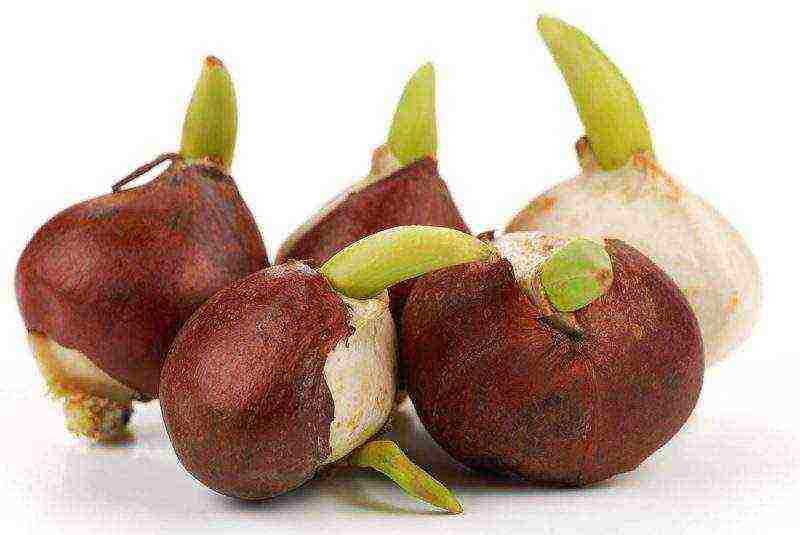
When buying, you should choose those bulbs that have a thin husk of a pleasant golden color. Cracks in the skin are normal.
The onion itself must be whole. If there is damage on it, then the purchase should be abandoned, since in this case it will not be possible to obtain a high-quality plant.
Choose an average size of the purchased onion, and when you take it in your hand, its weight should be felt. When examining the bottom of a good planting material, small root tubercles will be visible. If the bottom is soft, or the roots have already sprouted, you should not buy the bulb.
Time and timing of planting tulips
The homeland of the plant is Central Asia. In natural conditions, tulips bloom intensively in early spring, and after that they dry out and go into a state of dormancy. In gardens, their life cycle follows the same principle. Therefore, it is important to immediately accurately determine the correct planting date, since a mistake in it will lead to the death of the flower.
In autumn
Autumn is the best time to plant tulips. Experienced gardeners only plant bulbs in September and never move the planting time until summer or spring. It is advisable to choose a dry day for work. Details on how to plant tulips in the fall are described in the next section.
If the bulbs are planted too early, they will not only form roots before winter, but also release the aboveground part. As a result, tulips will freeze and may die. If the plant survives after this, then it will definitely not bloom.
Planting too late means that the bulbs do not have time to take root. For this reason, the plant hibernates incorrectly and in the spring, after spending the last effort on rooting, it no longer blooms. Also, tulips unrooted before frost can easily rot or freeze out.
In the event that for some reason it is necessary to plant plants at the end of October or even in November, when they do not have time to take root, the garden should be covered with spruce branches, or mulched with a thick layer of sawdust. Fallen foliage is also suitable for shelter.
In the spring
Spring is not the right time to plant tulips. The bulbs will be able to take root and even bloom in the middle of summer, but their life cycle will be seriously disrupted. Because of this, they will have to be dug out quite late, and, therefore, the autumn planting time will shift to late autumn.
It is best, if tulips are purchased in spring, to plant them in a container very early - even before the snow melts. After the onset of persistent heat, the plants are planted without removing them from the container, as this will facilitate their further digging.
How to plant tulips correctly?
When planting tulips, correct agricultural technology is of great importance, which allows the plants to be provided with the most comfortable conditions. Violations of it will lead to poor flowering and sometimes even rotting of the bulbs. Planting tulips requires adherence to certain rules.
Soil requirements, site selection
A site for tulips is chosen in the fall after the foliage has fallen from the trees. It should be very well lit. Since tulips will fade before the trees open their leaves, it is not scary if the flower bed is in the shade in summer. For plants, light is important only until the end of flowering. It is better to stir the flower bed out of the blue, where melt water does not accumulate.
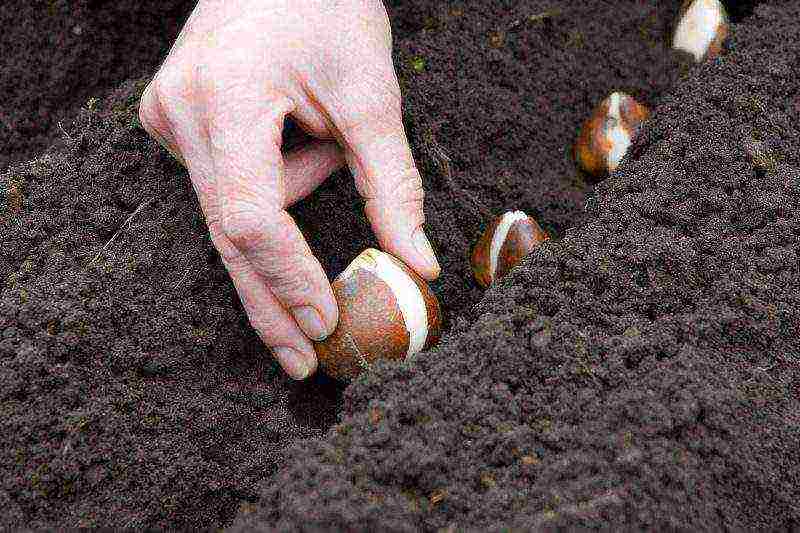
Tulips need soil that is neutral or slightly acidic, loose. The fertile layer needs a thick one. High water permeability and air permeability are also of great importance for the plant. Do not plant tulips in areas where bulbous crops or nightshades have previously grown. This is due to the accumulation of pathogens in the soil, which can transfer to flowers.
If the soil is heavy, then frequent loosening will be required. Without this, it is impossible to grow fully blooming tulips.
Landing in open ground
You can plant only healthy bulbs that do not have foci of decay and are not affected by diseases. Before planting, they must be soaked for 30 minutes in a slightly pink solution of manganese. After that, the bulbs are dried for an hour and planted.
It is more convenient to plant bulbs in furrows rather than holes, as this allows you to plant as many tulips as possible. The furrow spacing should be at least 25 cm for easy maintenance of the flowers and the bulbs can grow with enough soil and nutrients. The row spacing between the plants should be 10 cm.
How deep should you plant?

If the soil is light, the planting of the bulbs is deeper than with heavy soil. In the first case, the bulbs are planted at 3 heights, and in the second - at 2 heights. On average, this is 15 cm and 10 cm, respectively. You need to know that rooted bulbs will go even deeper.
Tulip care
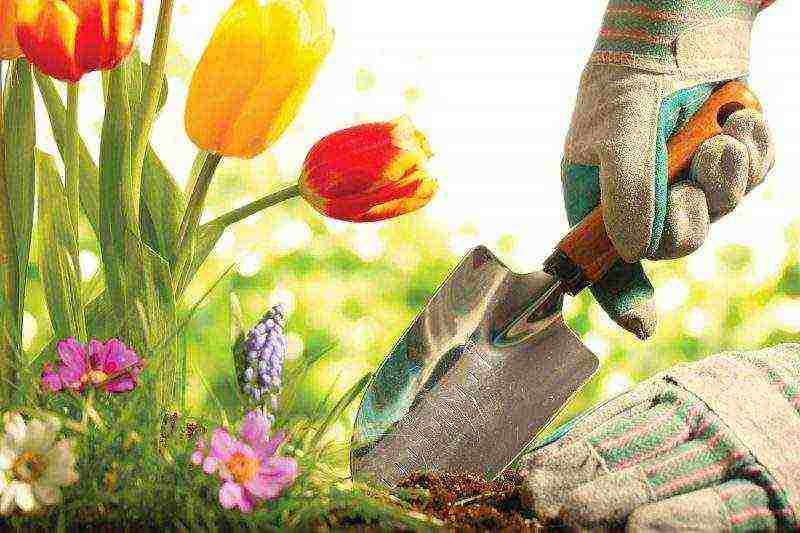
In addition to proper planting, tulips also require competent care, which will allow them to gain maximum strength for a particularly beautiful flowering. Despite all their unpretentiousness, varietal plants will not be able to feel good if they are left to themselves.
Watering and feeding
Plant feeding is carried out 3 times in the spring. Without this, the bulbs will not receive enough nutrients and will leave weakened during the rest period. In addition, a lack of fertilizing will lead to the fact that high-quality buds and large flowers will not form.
- First feeding. Carried out immediately after the tulips have emerged from the ground. Nitrogen fertilizers are used for it.
- Second feeding. Carried out when laying the buds. Complex mineral compositions with a high content of potassium and phosphorus are used for it.
- Third feeding necessary after tulips bloom. Potassium-phosphorus fertilizers are introduced.
Tulips react very positively to wood ash, which can be sprinkled on the soil before watering at any time.
Watering during flowering is very important for tulips. Water is poured at the root.
Usually 2-3 waterings per week are enough. After the flowers have wilted, the soil moisture is stopped so that the bulbs go into a dormant state.
Loosening

Loosen the soil around the tulips regularly after watering. At the same time, weeds are pulled out. If it is not possible to loosen the soil, you can mulch it.
Features of care after flowering
After the tulips have faded, they also need to be cared for. In order for the plant not to waste energy on the formation of seeds, the flowers, after they wilt, are cut off completely. Only leaves are left. The more leaves a plant has, the better.
When to dig up tulip bulbs?
The bulbs are dug out after the aboveground part of the plant has turned yellow. Do not try to pull them out by the stem, as if it breaks off, it will be difficult to remove the bulb. Due to the property of tulips, they will go deeper into the soil at the time of excavation, they will be deeper than when planting.
Storage conditions
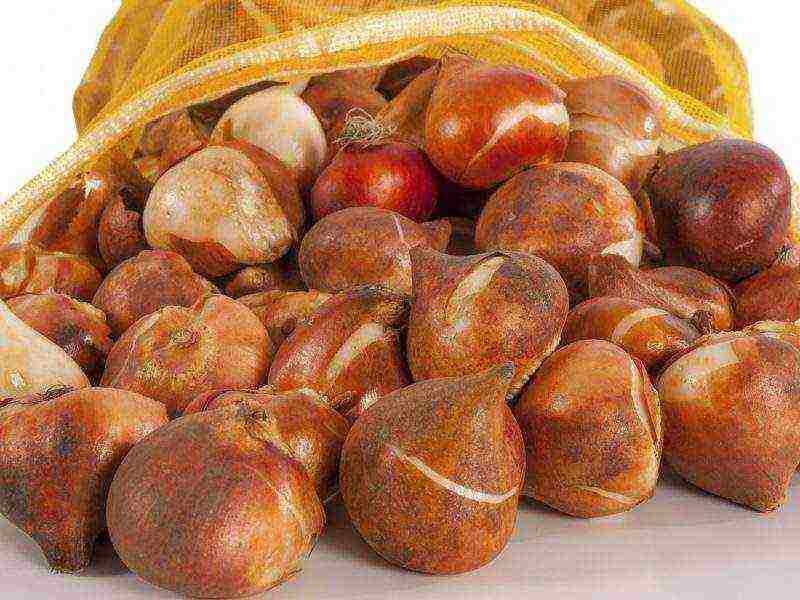
The dug out bulbs are dried in the shade under a canopy or indoors for a month. After that, folded in paper bags, they are removed until the autumn planting. The temperature at the storage location should be between +15 and +18 degrees. If spoiled bulbs are found, they should be discarded. They will not sprout in spring, but they infect the planting site.
Protection against diseases and pests
Whichever tulip variety is chosen, it can be subject to disease and pest attacks. If the plant is affected by fungal diseases, then to save the flower, it is necessary to transplant it to a new place and spill it with a 1% solution of Bordeaux liquid.
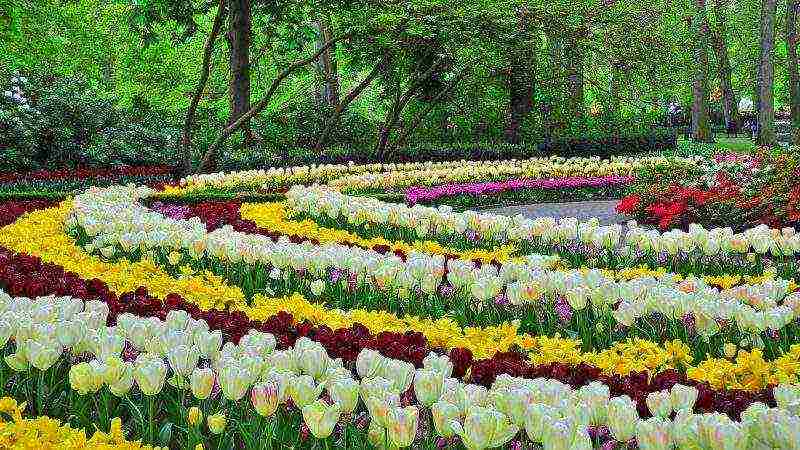
Of the pests, the main danger for tulips is:
- bulbous mite;
- slugs;
- snails;
- bear;
- rodents.
Mousetraps and poisoned baits are used to get rid of mice. From pests, special preparations are used that destroy insects and mollusks that attacked the flower.
Growing tulips is a fascinating activity that, due to the variety of varieties, often becomes a real hobby for a grower.

Who would have thought that tulips, the cultivation of which only five centuries ago was available only to the richest segments of the population, will now be found in almost every flower garden. These bright flowers have become real symbols of spring and the awakening of nature! But why do some tulips grow so gorgeous that it is difficult to take your eyes off, while others do not look very presentable?
Preparing the bulbs and choosing where to plant them
Although growing tulips in the open field is considered a simple matter, available to any novice gardener, in fact, you need to take into account many important details so that the plants turn out to be even, beautiful, with large flowers. Sometimes even minor mistakes can lead to such undesirable consequences as slow growth of tulips, rotting of stems or their curvature, the formation of small buds, wilting and rapid wilting of flowers, etc.

The key to beautiful, healthy tulips is a careful selection of planting material
Excellent results can be achieved if:
- a suitable place for planting tulips was chosen, with good soil and illumination;
- the bulbs were carefully sorted before planting, and unhealthy, damaged, small specimens were rejected;
- planting of bulbs took place at the most successful time for this;
- when planting, the planting depth and the distance between the bulbs were respected;
- right after the snow melted and until the end of flowering, the tulips were properly cared for.
Video about growing tulips
Let's take a closer look at what the tulip cultivation technology is, and what points you should definitely pay attention to.
The key to beautiful, healthy tulips is a careful selection of planting material. You can buy properly prepared and properly processed bulbs or harvest them yourself by digging tulips at the end of the growing season. When self-harvesting planting material, the bulbs are sorted and sent for storage in a dark place at a temperature of +20 degrees until autumn.
When the time is right for planting tulips, the bulbs are sorted out again, carefully examining them for damage, signs of disease and rot. Then the selected bulbs are cleaned from the upper husk, disinfected with a solution of potassium permanganate and immediately planted in the ground.

When the time is right for planting tulips, the bulbs are sorted again.
The place for planting tulips should be determined from the summer. And you need to not only take into account the illumination, the reaction of the soil and the occurrence of groundwater, but also think carefully about where the tulips will look best.In order for the multi-colored buds to become a real decoration of the garden and cause constant admiration among your guests and passers-by, it is worth exploring the options for placing tulips in the design of the garden.
The best conditions for growing tulips: a flat, unshaded area (only the most hardy varieties feel good under trees and in the shade of a house), the reaction of the soil is close to neutral, the soil is light and fertile.
Highlights of tulip planting
Most gardeners prefer to plant tulips in the fall so that they naturally go through a cooling period during the winter, during which new flowers sprout inside the bulbs. In spring, planting bulbs is also possible, but be prepared for later tulip flowering times.
Around the second half of September, when the ground temperature has already dropped to +10 degrees, and the frost has not yet begun, you should start planting tulips. To do this, grooves of suitable depth can be made in the garden bed, or a separate hole can be scooped out under each bulb with a scoop. On large areas, the planting material is laid out on a leveled surface and then evenly covered with earth.
Bury the bulbs in the ground so that the planting depth is equal to three times the height of the bulbs - large deeper, shallow closer to the surface. If the children are planted too deeply, the bulb will form much less.
The distance between the tulips can be arbitrary, depending on your design ideas, but it is still undesirable to place the bulbs closer than 10 cm from each other, otherwise they will then grow very closely, and digging the bulbs in the summer will be difficult.

Bury the bulbs in the ground so that the planting depth is equal to three times the height of the bulb.
The planted bulbs are sprinkled with fertile soil and the plantings are mulched with peat or humus to protect the plants from frost. Additional planting shelter for the winter is usually not required. You can find out in detail about the rest of the intricacies of planting tulips in the article on our website.
Tulip growing technology - what is important to consider?
In the spring, as the snow melts, they rake the mulch from the flower bed and gently loosen the earth. Further, it will be useful to apply nitrogen-containing fertilizer for better growth and development of the green part of the plants. In the future, during the entire growing season, do not forget to regularly loosen the soil and regularly water the garden bed. But remember that tulips should not be flooded too much - any stagnation of moisture threatens with decay of the roots.
When your flowers show their first shoots in the spring, see if all the bulbs have sprouted and do all the shoots look healthy? If signs of disease are found on some of the stems, they should be immediately dug up and destroyed. Non-sprouted bulbs can also be dug up without pity.
You can not be afraid of spring morning frosts, since tulips, even with the appearance of buds, calmly tolerate a short-term drop in temperature to -4 degrees. And as soon as the weather is good, the plants continue their development.

When your flowers show their first shoots in the spring, see if all the bulbs have sprouted and if all the shoots look healthy.
Tulips are very fond of fertilizing with fertilizers:
- a lot of benefits will be brought by the introduction of complex fertilization during the unfolding of the second or third leaf in tulip sprouts;
- before flowering, be sure to feed the tulips with phosphorus and potassium so that the buds are formed beautiful and large;
- complex mineral fertilizer will be useful during the blooming of flowers;
- fertilizers containing chlorine cannot be used for tulips;
- it is more convenient and safer to apply fertilizing in the form of aqueous solutions during irrigation, before the rain or immediately after it on wet ground.
Ready-made complex fertilizers are good because they contain the most important trace elements for tulips in an optimal ratio: boron, manganese, molybdenum, cobalt, zinc, sulfur, copper, iron, magnesium (while there is no chlorine harmful to tulips). A deficiency in any of these micronutrients can adversely affect the development and health of tulips.
So, with a lack of boron, molybdenum or zinc, tulips can develop chlorosis, the stems will be weak, if there is not enough sulfur in the soil, the leaves of tulips become light green or completely turn white, and from a lack of iron they turn yellow. A severe lack of magnesium leads to the fact that the edges and tips of tulip leaves begin to bend and die off, the bulbs of such plants will no longer be suitable for forcing.
Video about the cultivation, care and reproduction of tulips
When tulips are finished blooming, plant care should be continued for a while if you expect to harvest good, large bulbs for the next generation of beautiful flowers. In this case, it is recommended to break off the blossoming buds together with the pedicels - all the plant's forces will go to the formation of bulbs, and not to the development of the seed pod. Just do not pick off the leaves, otherwise the yield of the bulbs will decrease several times.
The stems of the tulips are left in the flowerbed until they turn yellow, until the bulbs are ripe. And if you do not like how a garden looks like with withered "stubs" of tulips, think in advance which plants can cover the unsightly picture. Another option is to grow tulips outdoors in special baskets or containers, which can be dug out of the garden immediately after flowering and transferred to a more inconspicuous place for growing the bulbs.
Rate the article:
(6 votes, average: 4 out of 5)


